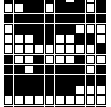
 |
The breath of Arrhenius - part 2 |
The first duty of an archivist is to prevent catastrophic, rapid damage to the collection. Figure 4 shows roughly where the limits lie.
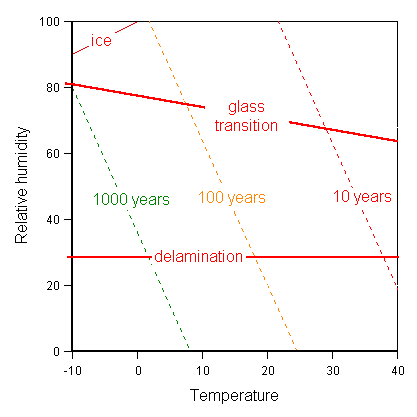
Figure 4 The factors that influence the durability of photographs. Above the glass transition of gelatin the film is likely to stick to its enclosure. Below the delamination line the differential shrinkage of gelatin and film base threatens to break their adhesion. The diagonal lines mark the time for acetate film base to reach an acidity that causes autocatalytic hydrolysis. The limit for physical damage through ice crystal formation in the gelatin is shown at the top left corner. We can find no quantitative data for limiting conditions for fungal damage. We have not observed biological attack in the humid Copenhagen climate and therefore use the glass transition as the limiting factor at high RH.
The high humidity limit is set by the glass transition of gelatin to a soft consistency which renders it liable to stick to its surroundings. We have taken, and simplified, the data of McCormick-Goodhart (3). The lower RH limit is set by the danger of delamination through differential shrinkage of the base and emulsion. We have taken the recommendations from the ANSI standard for glass plate negatives (4). The high temperature limit for catastrophe is the softening point of gelatin but we have conservatively used the 10 years to significant acetate film base acidity from Reilly et al (5). We use this as a general indicator of the rate of degradation reactions, rather than as a definite lifetime prediction. Ice crystallization in frozen film only occurs at very high RH. We include this to warn against unprotected storage in refrigerators. The region for biological attack on the gelatin is difficult to define. Silver is an effective biocide, acetic acid and phenol outgassing from acetate negatives are also poisonous to many organisms. We have never found biological decay in collections in temperate climates that could not have been caused by liquid water. We regard the softening of the film at high RH as setting the climate limit. Figure 5 is a simplified version of figure 4 which is used as the basis for building up the discussion.
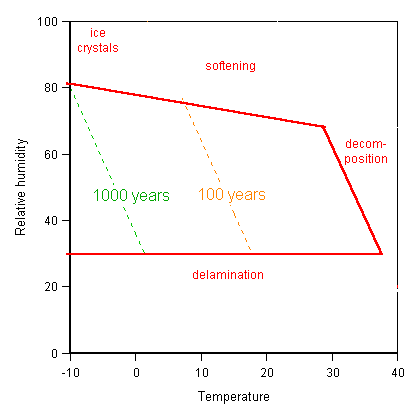
Figure 5 Suggested climate limits for the storage of black and white film, with contours showing the increasing chemical stability conferred by low temperature and, to a lesser degree, by low RH.
The exact position of the lines is not important because the aim must be to hold the climate well within the boundaries and over towards the left side of the diagram. The relaxed attitude to high temperature does not mean that we accept as safe a permanent climate in this region of the diagram. The diagram marks the limits of acute, immediate danger.
Figure 6 superimposes on this window of non-catastrophic temperature and relative humidity the climate at various places, representing different climate types (6). We have used the monthly average values for temperature and relative humidity, assuming a certain inertia in the storage room that will even out shorter variations.
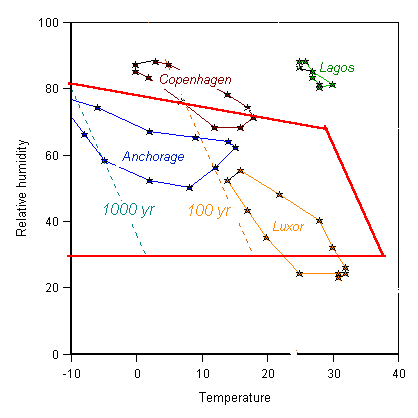
Figure 6 The monthly average temperature and relative humidity in various places, compared with the region of safe climate for storage of black and white photographs.
Notice that the hot humid climate of Lagos is immediately destructive to photographs and the winter dampness of Copenhagen lifts the gelatin above its glass transition. Luxor presents the opposite risk of delamination. Anchorage seems, climatically, to be an excellent place to store photos.
At this point we refer to the ANSI standard (7) for storage climate, for guidance on how radically we need to adjust the natural climate.

Figure 7 The natural climate in various places, compared with the ANSI standard storage climate for black and white film and the limits for safe storage suggested in this article.
Figure 7 includes the ANSI standard for the climate around black and white negatives. The standard teasingly nudges the edge of the area occupied by the world's natural climates. Standards have an authority that encourages acquiescence without deeper consideration, particularly by administrators who have little knowledge of the experimental or experiential basis for the standard. The climate standard for storage of black and white film is based on the predicted rate of hydrolytic decomposition of cellulose acetate film base, as extrapolated from accelerated ageing tests over a range of temperatures, using the Arrhenius method. A lifetime of better than 100 years seems to have been the guiding principle (8).
As we have already explained, it is quite often the image that deteriorates faster than the base. The standard is therefore optimistic in its implicit assumption that film is always processed to such a high standard that the durability of the base is the limiting factor in image storage. On the other hand the lifetime figures for the film base shown on the graph are pessimistic, as Reilly et al acknowledge, because they are based on the decomposition rate of film that was encapsulated in airtight bags so that the acid could not escape. This tight wrapping is only approached in reality with rolled film. Flat film stored in envelopes has been shown to lose much of the acetic acid vapour to the air (5). The standard also fails to take into account that glass plate, acetate and nitrate negatives, and maybe prints and slides, are often stored together. A single standard for archives, based on choosing a climate that lies within a matrix of limits for each of the various stored materials, would be more practical.
The standard is therefore somewhat arbitrary. The general trend is parallel to the line of constant deterioration rate according to Reilly et al. but the precise positioning from left to right is a compromise between the ideal storage temperature, 0K, and the most extreme terrestrial climate at about 310K (37C).
The position of the standard in T-RH space has one important consequence that is not immediately obvious: it requires unusual air conditioning technology. The zigzag standard limit follows the -3C frostpoint, as shown in figure 8.
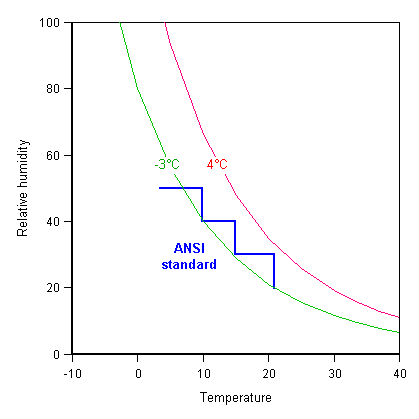
Figure 8 The ANSI standard superimposed on lines showing the RH and temperature corresponding to a -3C frost point and a 4C dew point temperature.
The frost, or dew, point is significant, because this is the temperature to which the air conditioning equipment must cool the air to dehumidify it, by condensation of water or ice. The air is subsequently heated up again so that its RH falls to its set value as the temperature rises to its set value. A dew point below freezing needs a cooling surface cooled by an antifreeze solution, or by direct expansion of refrigerant, and it also requires a defrosting cycle. Air conditioning for human comfort operates with air at a dew point above 4C, which is usually achieved by condensation onto a surface cooled by recirculating cold water. The climate attained with air at this dewpoint cannot be drier than 32% RH at 21C, or 47% at 15. The standard therefore requires more expensive, though well developed, techniques. The low temperature option in the standard also requires airtight construction to avoid condensation on the outer wall of the cooled room.
Whether one is rich or poor, there is no profound, logical reason to stick exactly to the ANSI (ISO) standard (9). It is expensive for the poor and not particularly good at preserving the pictures of the rich. It requires, everywhere, the installation of mechanical systems, which can fail with far more catastrophic results than an unclimatised building can ever achieve.
The lifetime of an air conditioning installation is about twenty years. The lifetime of the photographic standards has proved to be even shorter (10). Less than ideal climate control that still ensures a slow rate of deterioration will hold the collection in readiness for the possibilities of a future with infinitely durable digital preservation (if one remembers the code) on gold discs. The question is how far one can move out beyond the standard limit into the warm, damp area of the diagram without risking being judged an irresponsible curator of irreplaceable records.
We use Copenhagen as a model for a marine temperate climate. The simplest way to reduce the relative humidity to bring the climate within the safe range for a photographic store is to warm the air. Figure 9 shows the natural climate, at the top of the diagram.

Figure 9 Climate change caused by heating and by dehumidification. The monthly average climate of Copenhagen is shown in the top ring of stars. The middle, flattened ring shows the effect of heating the air to reduce the RH to 50%. The lowest ring shows the result of dehumidifying to come close to the ANSI standard.
The flattened ring in the centre represents the consequences of warming to maintain 50% relative humidity throughout the year. This is not a particularly attractive option because the temperature moves towards the rapid reaction side of the diagram. This system operates in the State Archive of Schleswig-Holstein, Germany, and is described by Christoffersen (11). It has the advantage that in a sufficiently insulated building the necessary heating, about five degrees above ambient, is provided by very modest human activity and low level, intermittent lighting. The radiator heating system installed at Schleswig has never been needed.
An alternative strategy is to dehumidify the air. Dehumidification to bring the climate as close as possible to the standard is shown as the lowest ring of stars in the diagram. Notice that the climate is still displaced to a slightly higher temperature. This is an automatic consequence of dehumidification without cooling. The points on figure 9 represent the result of passing air in any quantity through a perfectly insulated room. In practice the air change will be held to the minimum needed to ensure adequate ventilation and the room will lose heat to the outside, bringing the summer temperature closer to the standard specification. Note that an extremely massive and well insulated building is not necessarily the correct structure. Careful design is necessary to get the optimum result from simple strategies.
This dehumidification system is used in the museum stores of the Danish National Museum. It is described by Padfield and Jensen (12).
Underground storage provides great temperature stability. The photographic archive in Mo i Rana in north Norway is built in a cavern which has a natural climate of 8C and 100% RH. This is dehumidified to 35% RH (13). The alternative strategy of warming, to 15C for example, would only reduce the RH to 60%. In general, dehumidification is preferable in store rooms, because the air change can be kept small. In rooms used by people the necessary air exchange, and the need for reasonable warmth, often makes heating a more attractive route to a low RH in a cool climate.
Observations on collections of photographs show that the rate of deterioration is very variable, depending as much on the quality of the processing as on the inherent stability of the materials. The current standard for storage climate is a compromise that will still allow the deterioration of badly manufactured or processed film but demands expensive equipment that is not necessary for the survival of film and prints that are in good condition. The standard emphasises the importance of the room climate but observation suggests that pollution of the microenvironment by relatively few decomposing negatives is a frequent cause of damage to sound material nearby.
We suggest an approach to collections management which eases the climate specification for the bulk of the collection, allowing relatively simple and cheap manipulation of the local climate. This relaxed approach to climate control is compensated by regular surveying of the collection with eye, nose and chemical sensors. Decaying images are found and put into a cold store to retard deterioration and to allow later preservation of the image by copying and possibly by chemical treatment.
1. Johnsen, J.S.: 'Image Quality of Chemically Restored Black and White Negatives', Journal of Imaging Science and Technology 36 (1992) 46-55.
2. Padfield, T. and Johnsen, J.S.: Preservation of Photographs in a Humidity Controlled Freezer'. In: Preventive Conservation: Practice, Theory and Research. Summaries of the Posters at the Ottawa Congress, IIC, 12-16 September 1994.
3. McCormick-Goodhart, M.H.: 'Moisture Content Isolines and the Glass Transition of Photographic Gelatin; their Significance to Cold Storage and Accelerated Aging', in this publication.
4. Adelstein, P.Z., 'Standards on the Permanence of Imaging Materials', in this publication.
5. Reilly, J.M., Adelstein, P.Z. and Nishimura, D.W.: 'Preservation of Safety Film. Final Report to the Office of Preservation, National Endowment for the Humanities,' Image Permanence Institute, Rochester (1991) 103.
This report is summarised in: Adelstein, P.Z., Reilly, J.M., Nishimura, D.W. & Erbland, C.J.: 'Stability of Cellulose Ester Base Photographic Film: Part I - Laboratory Testing Procedures', Journal of the Society of Motion Picture and Television Engineers, May (1992), 336-334, and in reference 8.
6. Cappelen, J. and Jensen, J.J.: 'Jordens Klima, Guide til vejr og klima i 156 lande [The Earth's Climate, A guide to weather and climate in 156 countries], Danmarks Meteorologiske Institut, Copenhagen (1989).
7. American National Standard Institute (ANSI): 'American National Standard for Imaging Media - Processed Safety Photographic Films - Storage', ANSI/NAPM IT9.11-1993, American National Standards Institute, New York. (1993).
8. Adelstein, P.Z., Reilly, J.M., Nishimura, D.W. & Erbland, C.J.: 'Stability of Cellulose Ester Base Photographic Film: Part II - Practical Storage Considerations', Journal of the Society of Motion Picture and Television Engineers, May (1992), 347-353.
9. The ANSI standard is normally approved as an ISO standard through a procedure described by Adelstein in ref. 4.
10. Since 1971 the standard for storage of safety films has been revised 8 times: ANSI PH1.43-1971, 1976, 1979, 1981, 1983, 1985. In 1991 the standard changed from ANSI PH1.43 to IT9.11-1991, 1993.
11. Christoffersen, L.D.: 'Resource-saving Storage of Historical Material' in: ICOM Committee for Conservation, 10th Triennial Meeting, Washington, DC (1993) 601-604.
12. Padfield, T. and Jensen, P.: 'Low Energy Climate Control in Museum Stores' in ICOM Committee for Conservation, 9th Triennial Meeting, Dresden (1990) 596-601.
13. Dahlø, R.: 'The building of the National Library of Norway ....some enterprise that hath a stomacke in't'' in Proceedings of the Conference of the Institute of Paper Conservation, Manchester 1992, ed. S. Fairbrass, pp 141-145.

This work is licensed under a Creative Commons Attribution-Noncommercial-No Derivative Works 3.0 License.